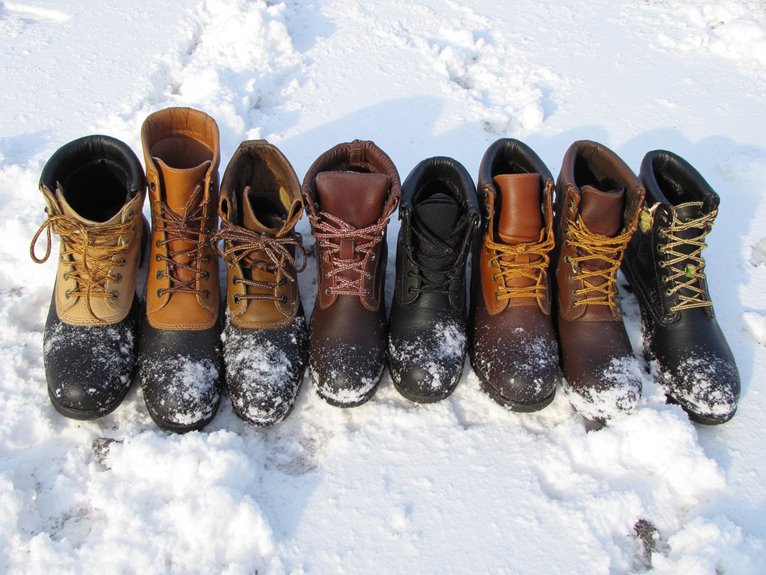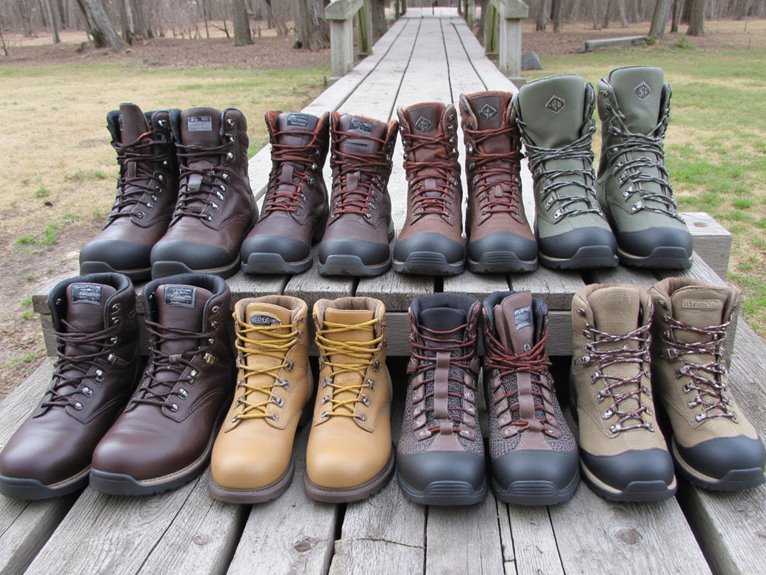What Not to Wear on a Hike?
When venturing into hiking, avoid wearing cotton clothing, as it absorbs moisture and can lead to discomfort and health issues. Jeans are also a no-go, as they're heavy when wet and offer little protection from the elements. Flip-flops and sandals are hazardous on the trail, lacking support and traction. High heels and loose accessories can cause accidents, while bright whites and neon colors can startle wildlife. Instead, opt for breathable fabrics, sturdy boots, and earthy tones. By knowing what not to wear, you can guarantee a safer and more enjoyable hike. Discover the best choices to make the most of your hiking experience.
We are supported by our audience. When you purchase through links on our site, we may earn an affiliate commission, at no extra cost for you. Learn more. Last update on 19th December 2025 / Images from Amazon Product Advertising API.
Cotton Clothing Is a No-Go
Because cotton absorbs and retains moisture, making it a poor choice for hiking attire that requires quick drying and breathability.
When hiking, it's essential to wear clothing that wicks away sweat and dries rapidly to prevent discomfort and potential health issues.
Cotton's inability to do so makes it an unsuitable choice for hiking. Additionally, cotton clothing can become heavy when wet, leading to discomfort and fatigue.
Instead, opt for synthetic or merino wool fabrics that provide moisture-wicking properties, keeping you dry and comfortable throughout your hike.
Flip-Flops and Sandals Are Taboo
Flip-flops and sandals, often favored for casual outings, are conspicuously absent from the hiker's wardrobe, and for good reason. These types of footwear offer little to no protection or support for the feet, making them a hazardous choice for hiking.
Lack of ankle support: Flip-flops and sandals leave ankles exposed, making them prone to twists and sprains.
Insufficient traction: The smooth soles of flip-flops and sandals provide little grip on uneven terrain, increasing the risk of slips and falls.
Exposure to elements: Open-toed shoes leave feet vulnerable to harsh weather conditions, rough terrain, and potential hazards like sharp rocks or hot surfaces.
Opt for sturdy, closed-toe hiking boots or shoes with good traction and ankle support to guarantee a safe and enjoyable hiking experience.
Jeans Are Not Your Friend
Your hiking companion's worst enemy might be lurking in their closet, disguising itself as a comfortable and familiar favorite: jeans.
While they may seem like a comfortable choice, jeans are a poor option for hiking.
They absorb moisture, making them heavy and cold when wet, and can chafe and cause discomfort.
Additionally, denim is a thick, heavy fabric that restricts movement and can make it difficult to navigate rugged terrain.
In addition, jeans offer little protection from the elements, leaving hikers vulnerable to wind, sun, and rain.
Moreover, opt for breathable, water-resistant fabrics like polyester or merino wool instead.
Your hiking experience will thank you.
Silk and Nylon Don't Mix
Silk and nylon, two popular fabrics often found in outdoor clothing, can create a disastrous combination when paired together in a single garment, leading to a hike-ruining experience.
When these fabrics come into contact, they can cause friction, leading to pilling, snagging, and even holes. This can result in a loss of insulation, compromised waterproofing, and an overall decrease in garment performance.
Reduced durability: The friction between silk and nylon can cause the fabric to break down more quickly, reducing the lifespan of your gear.
Increased risk of damage: The pilling and snagging that occurs when silk and nylon meet can lead to tears and holes, leaving you vulnerable to the elements.
Decreased performance: When silk and nylon are paired, the performance of your gear can suffer, leaving you cold, wet, and miserable on the trail.
High Heels on the Trail
In the realm of hiking, high heels are a recipe for disaster.
The increased heel height can cause loss of balance and stability, making it difficult to navigate uneven terrain, while the narrow toe box and thin soles offer little protection from rough trails.
As we delve into the pitfalls of high heels on the trail, we'll examine the hazards of heel height, the perils of unstable ground, and the guaranteed damage to trails.
Heel Height Hazards
Hiking trails are no place for high heels, as the raised heel height can lead to a host of problems, including ankle twists, knee strains, and even falls. The instability and lack of traction provided by high heels can make it difficult to navigate uneven terrain, steep inclines, and slippery surfaces. This can lead to accidents, injuries, and a range of other issues.
Reduced balance and stability: High heels can cause you to lose your balance, making it difficult to maintain your footing on uneven terrain.
Increased risk of ankle sprains: The raised heel height can cause your ankle to twist and roll, leading to painful sprains and strains.
Decreased traction: The smooth surface of high heels can fail to grip the ground, increasing the risk of slips and falls.
Unstable Ground Ahead
High heels on the trail can lead to a precarious situation, as the uneven terrain and varied surfaces of hiking trails can quickly turn into unstable ground.
The slender heel and narrow toe box of high heels provide little stability on uneven terrain, making it difficult to maintain balance.
This can lead to slips, trips, and falls, which can result in injuries.
Additionally, high heels can cause erosion and damage to the trail surface, widening the path and causing long-term damage to the environment.
It's essential to prioritize stability and traction when hiking, and opt for sturdy, low-heeled boots or shoes with good grip to guarantee a safe and enjoyable hiking experience.
Trail Damage Guaranteed
Wearing high heels on the trail not only poses a significant risk to personal safety but also guarantees trail damage, as the concentrated pressure from the heel can compact and displace soil and vegetation, leading to erosion and long-term environmental harm.
High heels can cause irreparable damage to the trail in several ways:
- Soil compaction: The concentrated pressure from the heel can compact the soil, reducing its ability to absorb water and support plant growth.
- Vegetation displacement: The heel can displace vegetation, leading to erosion and increased sedimentation in waterways.
- Trail widening: The instability of high heels can cause hikers to widen the trail, leading to further environmental degradation.
It's essential to prioritize trail preservation and hiker safety by choosing appropriate footwear for hiking.
Loose Accessories Are a Hazard
At least one in five hikers has experienced an unfortunate encounter with a loose accessory getting caught in a branch or underbrush during a hike.
This can lead to frustration, delays, and even injuries.
Loose accessories such as dangling jewelry, hats with loose straps, or backpacks with loose straps can easily get entangled in vegetation or snag on branches.
To avoid these mishaps, it's essential to secure all accessories before venturing out on a hike.
Opt for accessories with secure fastenings, and avoid wearing anything that could potentially get caught.
Bright Whites and Neon Colors
When venturing into the wilderness, it's essential to prioritize blending in with the surroundings.
Bright whites and neon colors, however, have the opposite effect, making you stand out in a way that's more conducive to attracting unwanted attention from wildlife or other hikers.
Standout in the Wrong Way
Brightly colored clothing, particularly whites and neon hues, can be a liability on the trail, making it easier for wildlife to spot you and increasing your visibility to other hikers who may be seeking solitude.
While it may be tempting to wear your favorite bright shirt or neon socks, it's essential to prioritize blending in with your surroundings. This is especially vital in areas with sensitive wildlife habitats or where you're sharing the trail with other outdoor enthusiasts.
Three reasons to ditch the brights:
- Avoid startling wildlife: Bright colors can startle animals, causing them to flee or become aggressive.
- Respect fellow hikers: If you're sharing the trail with others, consider wearing muted colors to minimize distractions.
- Enhance your outdoor experience: By blending in, you'll be more likely to spot wildlife and enjoy a more immersive outdoor experience, which is fundamental to a successful and enjoyable hike.
Attract Unwanted Attention
Neon hues and bright whites serve as landmarks, drawing unnecessary attention from both wildlife and fellow hikers, undermining the tranquility of the outdoor experience.
These colors are particularly problematic in wilderness areas, where they can disrupt the natural habitat and startle animals.
Additionally, they can also make you more visible to other hikers, compromising your ability to enjoy a peaceful, solitary experience.
In addition, they can have a profound impact on the ecosystem.
Opt for earthy tones, such as greens, browns, and tans, which blend seamlessly with the natural environment.
These colors allow you to move quietly and unobtrusively, respecting the wildlife and preserving the serenity of the great outdoors.





